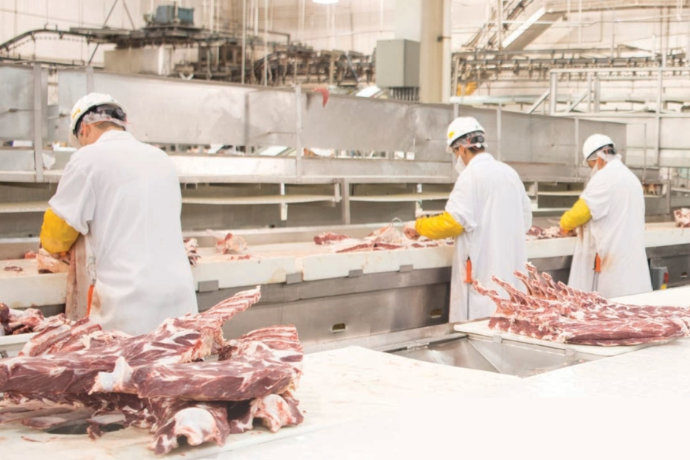Every beef plant is comprised of the same basic components to achieve their manufacturing mission. Each plant has cattle pens, a slaughter floor, carcass storage coolers, a fabrication area, and a packaging and shipping area. Many plants also have further processing components, such as ground beef and case-ready processing.
Despite these common features, each plant has its own unique identity – characteristics setting it apart from others of similar makeup. After 40 years of inhabiting various plants around North America, I’ve come to appreciate that these plants are not just bricks and mortar, concrete and steel. They are living and breathing organisms, uniquely grown into what they are today. In that sense, the argument could be made that “plants are animals too.”
Although sharing common functional areas, plants vary widely throughout the industry. The mega plants of southwest Kansas, Nebraska, and Texas are designed to run large volumes with a scale to match. Other plants grew from small operations, adding size and scope over years and in some cases, generations. One family business in Pennsylvania grew over the course of 30 years and two generations, from seven employees who did everything, to a plant with over 1,100 employees and one of the largest beef plants in the Northeast. On the other end of the spectrum, a large Midwest plant built nearly 40 years ago was designed from the start to slaughter and process 6,000 head per day. It, too, has seen many changes over the years, but its core production is still around 6,000 head per day.
Long view
History plays a large role in how beef plants have evolved, but there are some elements of plant structure that are important whether the plant is large or small, new or old. Dave Kaminski is the owner of Plainview, Texas-based Packers Design and Consulting LLC, and has been working in beef plants since 1973. He advises companies to take a long-term view when considering modifications.
“I always tell companies to look at a 15-year plan. One plant I worked at put on a new hot box five years ago. I said at the time that we need to look at what changes that is going to require for the future. So, we put together a 15-year plan.” Few would argue that is an organized approach to present and future expansion.
The biggest mistake plants make, Kaminski says, “is predefining the size of the expansion without considering the volume.” Sometimes what the plant can afford to spend does not facilitate the production intended to go through it. “Process should dictate what the size of the building is. When you try to shoehorn a process in a predetermined space, something will suffer.”
Design execution is also important. A plant might be able save money by hiring a good metal fabricator to build a conveyor system because they have the lowest bid. However, if the conveyors aren’t built and installed correctly, there can be serious yield loss. A relatively new beef plant Kaminski worked with was recently losing tens of thousands of dollars a week in beef trimmings loss due to poorly built conveyors.
“Getting the right contractors is really important,” Kaminski emphasizes. For example, “A company that has built a lot of conveyors for a lot of plants will cost more up front but will save a lot of money in the short and long run,” he says, through good execution.
People power
Plants are often talked about in anthropomorphic terms. A well-built plant is said to have “good bones;” the outside area where scrap equipment parts are parked is often referred to as “the boneyard.” In this vein, people are often referred to as “the heart” of the plant. Eric Reynolds is a longtime safety consultant who has helped companies improve their safety metrics. At the foundation of improvement, he says, is culture. “Employee culture is the heartbeat of the plant,” he says.
Culture may seem an amorphous and elusive quality, yet most companies today are seeking to harness its benefits. While difficult to measure directly, Reynolds says, “There are lagging indicators that point to a successful culture, including turnover rate, absenteeism and safety metrics.”
While seeking to find ways to directly gauge culture, one thing is certain: Companies understand the power – economic and otherwise – of an involved, engaged workforce. Just like good health doesn’t just happen, neither does good culture. It requires a planned approach, with good diet and exercise.
Scott Hardiman, general manager at the JBS beef plant in Souderton, Pennsylvania, says it begins with the right attitude.
“A strong culture starts with recognizing that every team member is equally important, regardless of their title, position or responsibility,” he says. “If every team member understands their importance, they will care more about their role and how they can contribute to the shared success of the team.”
Involving employees in the process is integral to engagement. Improvement processes like Six Sigma and Kaizen require employee involvement to solve problems and get to solutions, which empowers employees and develops ownership in the workplace. Hardiman emphasizes, “The effort we invest into developing the management team directly impacts culture. We need to have a good plan and work the plan. It’s not easy, but it’s not hard. You get up every day and do the right thing.
“When you have a strong culture, the team is more engaged, and everything…everything gets better. If you don’t have a strong culture, you won’t achieve good business results at any level of consistency. Sure, you can perform well in the short term with a poor culture, but long-term sustainable results are only possible when your team members are engaged and the true focus of your culture.”
Each beef plant has its own story to tell, a story of birth, growth, maturity, of survival and vitality. And those stories are still being written, in both the physical body and the non-physical essence that drives the life in each facility. After all, “plants are animals too.”




